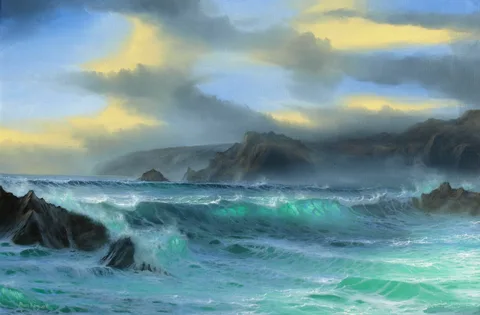
The coast has captivated artists for centuries. Shorelines represent liminal spaces between known and unknown – the meeting point of Earth and sea. This has spurred creative visions spanning realism to abstract interpretations. In this post, we’ll explore the evolving role of oceans in art and culture.
Early Seascape Paintings
Before the 19th century, few maritime paintings depicted oceans themselves. Classical seascapes focused on ships or mythological marine creatures while leaving the water as a mere background.
Dutch Golden Age artists pioneered seascape painting as a distinct genre. Realist maritime works from the 17th century highlighted dynamic skies and waves to capture the essence of North Sea environs. Artists like Ludolf Backhuysen, Jan Porcellis, and Simon de Vlieger set standards for the style.
By drifting from strict nautical documentation towards atmospheric studies, the Dutch infused monumental drama in classical seascapes. Their novel compositions and cloud-filled skies received acclaim across Europe for evocative power.
Ivan Aivazovsky later redefined seascapes through explosive Russian Romanticism in the mid-1800s. His dynamic paint handling conjured silver-lit Black Sea scenes with visceral passion. Critics accused Aivazovsky of over-dramatization, but the public loved his turbulent visions of Nature’s fury.
JMW Turner likewise shocked British audiences with radical impressions of churning oceanic chaos. Decades ahead of Impressionism, Turner’s quasi-abstract seas dissolved spatial boundaries with a proto-expressionist style. Critics called his maritime experiments ‘pictures of nothing and very like.
These revolutionaries enabled later artists to engage seascapes with greater creative liberty. Their influence endures through art history’s oceanic visions.
Coastlines In American Art
American Luminists like Fitz Henry Lane, Martin Johnson Heade, and Albert Bierstadt adapted influences from Dutch seascapes through native settings like:
- Atlantic Coast of New England
- Great Lakes
- California Coast
Heade’s beach and marsh scenes encapsulated the serene radiance of coastal light. Bierstadt applied his signature Rocky Mountain grandeur to ocean pieces. Fitz Henry Lane illuminated the majesty of the Maine shoreline through intricately detailed ship portraits.
Lane’s coastal documentarian focus dominated the genre until the 1860s. The influx of artist colonies brought Impressionist influences to East Coast waterfronts. Painters attended Académie Julian in Paris before funneling French styles into American seascapes.
Most famous was the Shinnecock School, nestled in eastern Long Island. William Merritt Chase, Childe Hassam, Willard Metcalf, and other air painters reveled in radiant Atlantic coast light. Quick oil sketches evoked the fleeting poetry of sea and surf.
Both American coasts saw surges of Impressionistic interpretation around the turn of the century. Even photographers like Alfred Stieglitz captured abstract coastal studies reflecting modernist approaches to common water themes.
These restless experiments dissolved海boundaries between artistic genres. Seascapes evolved from quaint ship portraits into vibrant embodiments of Nature’s energy.
Expanding Expressions of Coastal Life
As European modernism triggered new availability for abstraction, depictions of shorelines followed suit. Fauvists, Cubists, and Futurists all integrated ocean motifs as they deconstructed spatial assumptions.
Coastal communities like Saint-Tropez and Cadaqués became meccas for experimentation. Matisse, Derain, Picasso, Duchamp, and Dali, among others, found inspiration in the villages and beaches. Their bold colors, angular forms, and dream imagery filtered commonplace maritime settings into exotic worlds.
German editor Christian Ferdinand Mourier first coined the term “avant-garde” in the 1860s to describe experimental marine battleship formations. This military phrase soon described groundbreaking art instead. The connection remains fitting; like uncharted seas, modernism’s unexplored directions necessitated risk and discovery.
Many modern masters continued finding inspiration along the waves. From Joan Miró’s abstracted dream beaches to Marc Chagall’s floating figures, oceans permeated 20th-century abstraction. Coasts encouraged creative liberation from convention – just as they first did for JMW Turner and Ivan Aivazovsky.
The Ocean As Muse
The lure of oceans and lakes as creative springboards persists through today. Contemporary creators like David Hockney, Gerhard Richter, and Hiroshi Sugimoto reinvent aquatic motifs for current generations.
Photographers, in particular, leverage seascapes to challenge assumptions about Truth in image-making. Sugimoto’s eerily empty horizons question timelessness. Thomas Joshua Cooper and Anne Noble use antiquated techniques on radioactive seascapes conveying environmental unrest.
This conceptual activism brings us to evolving subjectivity in Coastal art prints. As climate change and ocean pollution breathe new urgency, depictions increasingly highlight conservation over idyllic charm. Waves morph from venues of painterly experimentation into reminders of Nature’s scale.
The Ecological Coast
Land and environmental artists now reshape shorelines into monumental earthworks underscoring habitat fragility. Christo’s fleeting vistas frame coastlines as impermanent. James Turrell’s ocean-perceiving chambers connect tides and lunar cycles through immersive light.
Platforms like the Cape Farewell Project directly confront global warming by sailing artists through Arctic and Antarctic waters firsthand. The experiences then fuel visual responses spotlighting climate change for worldwide audiences.
Photographers like David Liittschwager and Zena Holloway portray the ocean not through distant panoramas but intimate wildlife portraits revealing the planet’s interconnected networks. Liittschwager’s macro coral geometry echoes Cubist Braques. Holloway illuminates alien beauty within dark seaborne bioluminescence resembling cosmic nebulas.
For millennia, the ocean has authenticated existence beyond human scope. Its secrets kept imagination afloat. Yet through distilling oceanic habitats into aesthetic Abstractions, we risk further disconnection. Thus, a haunting quandary now shadows wave-borne creativity – how to honor Nature’s power while invoking conservation.
Can beauty alone salvage what we’ve exploited? Coastal art presses this question upon our shores.
Summing Up Seas In Artistic History
From classical ship portraits to environmental spectacles, oceans influence art across centuries and cultures. Artists return to the sea to harness its elemental rhythm and lose themselves in the vast unknown.
In maritime paintings, musical motifs, sculptures, poetry, and literature, creatives translate the ocean’s pulse into a sensory experience. They abstract life’s essential currents – eroding shores, swelling storms, and endless horizons – into visceral essence.
We, in turn, project identity upon waves through artistic interpretation. Shifting styles reflect cultural temperaments. Radiant color fields shine in boom years while somber ashcan scenes match hardships. Now, ecological unrest colors seascapes in anxious hues.
Yet if seascapes disclose humanity’s changing self-perception, they also reveal timeless truths. Breakers dissipate yet to return, unruly yet serene. In Nature’s cyclical balance, we locate consolation. As long as waves wash shores, artists will reframe oceanic constancy into contexts we fathom.
We cling to land yet yearn toward the sea – this is coastal art’s perpetual tension. Standing at the border between known and obscure, creative visions reflect discoveries that lure us deeper out and beyond. Just as the ocean’s surface veils lie below, its allure rests in the hidden. With each painted mystery, seas beckon new understanding. Their creative depths will never be charted.










